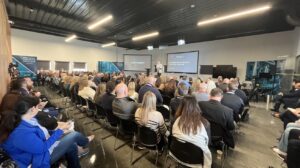From the fleets of wind turbines sprouting up all over the globe (3,000 new units each year in the U.S. alone) to the promise of better batteries that can smooth out supply and demand gaps, change and growth in the renewable energy sector are constant. With 280 gigawatts of new capacity coming online in 2020 alone—representing 90% of all new generation and a growth rate of 45% in the renewables sector—efficient, reliable, and sustainable technology is vital to successful implementation and optimization.
The growth that brings new players into the hot market makes it more important than ever for operators to maximize their ROI. That’s especially the case for those with a mix of wind, solar, and energy storage assets.

Mixed assets increase demands on operators
With the evolution of renewable generation moving away from single-sources (i.e., wind or solar only) and toward mixed-source portfolios, operators no longer have the luxury of specializing in a single generation type.
The increasing diversity is made possible by the constantly falling capital cost of wind and solar assets. However, the increased O&M demands of a more varied portfolio are causing operating costs to account for an increasingly significant percentage of profitability calculations.
In a recent webinar for renewable energy operators, Rob Budny, SparkCognition’s vice president of sales for renewable energy, said manually administered maintenance programs and working with a number of different original equipment OEMs introduce many variables into O&M that negatively impact production or overlook opportunities to take advantage of increases in energy demand or pricing.
“As the capital costs have decreased, the operating expenses have become a larger part of what’s called the levelized cost of energy, and what we see is that operating expenses vary widely from project to project and from operator to operator,” he said. “We see a big range in OpEx, and one of the factors is what the operational maintenance practices are. We see that as the asset mix becomes more complicated.”
SparkCognition Renewable Suite:
- Brings a scalable, cloud-based solution to renewable energy projects with a mix of assets
- Uses powerful physics-based, AI-enabled models that reliably predict failures and identify fixes for maintenance issues
- Spots and addresses underperforming hardware
- Ensures security against the increasingly prevalent threat of cyberattacks
- Uses unstructured data such as seismographs, historical maintenance logs, and video footage to tap into the estimated 80% of information that has been historically difficult to incorporate into maintenance and performance management programs
The potential for increased ROI
Budny said the advantage of making AI technology a fixture in managing renewable energy projects comes down to a simple question of maximizing return on investment at a time when power purchase agreements are growing shorter—10 to 15 years versus a typical asset life of 20 to 25—and putting more price pressure on providers. With the total costs of avoidable expenses and lost energy for renewable projects expected to reach $32B annually by 2023, there is incredible value available from relying on AI technology that is growing more powerful and effective every day.
“There’s some maintenance and safety use cases that are very compelling, as well as the net result meaning greater production, higher efficiency, and a really compelling return on investment,” he said. “It’s a full spectrum asset performance management platform. We have the ability to monitor and report and have operations enhanced by data from effectively monitoring a large number of assets.”
The results from Renewable Suite for wind, solar, and storage projects have been striking. For turbine operators, it has detected yaw error up to 5-10% with minimal historical data, preventing a year or more of decreased production before the issue can be addressed. Pitch bearing failures are also detected months in advance by analyzing problems due to age, motor currents, motor temperature, or pitch position, providing the ability to batch maintenance work and parts procurement to reduce costs.
For solar projects, tracking capabilities that can cause drops in productivity are monitored 24/7, with real-time alerts created for drastic issues in production. Improved soiling management allows for costly cleaning procedures to be optimally timed or possibly eliminated by utilizing rain events to naturally remove soil and debris.
The effectiveness of energy storage systems can be maximized by reducing and anticipating capacity loss, with better management of charge and discharge cycles that decrease wear on the physical properties of batteries. By monitoring and forecasting pricing demands, operators can time those cycles to take advantage of the most profitable windows to supply power to the market.
No matter how experienced an operator or management team is, AI is the new norm in renewable energy. With annual production performance increases of 2% typical for most projects, the ROI on Renewable Suite is clear.
“One of the beautiful things about renewables is your fuel is free, so if you can increase production, it goes straight to the bottom line. And so, a 2% energy increase may not sound like a lot to the layperson, but what we know in this industry is that a 2% increase could increase the profitability of the project by 10%,” Budny said.
















